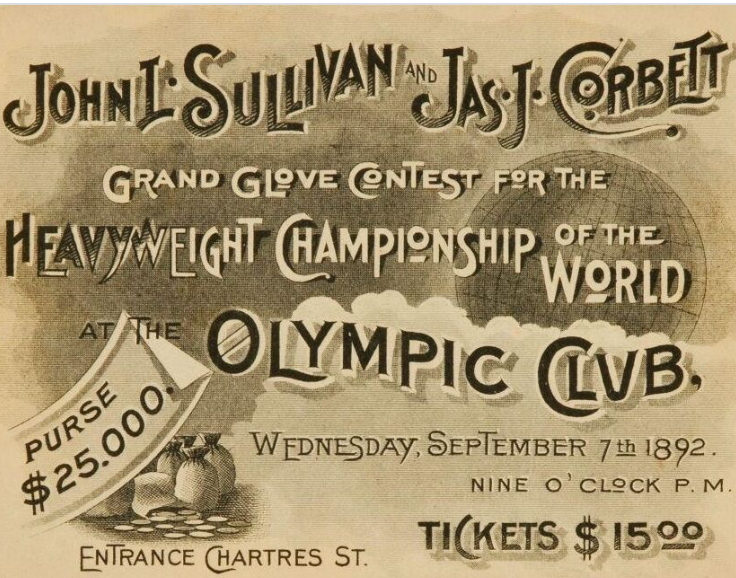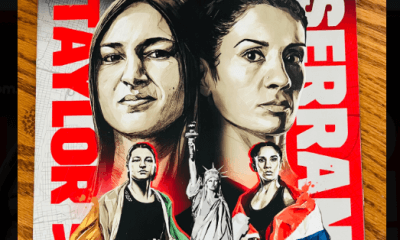Featured Articles
A Closer Look at John L. Sullivan and James J. Corbett and their ‘Watershed’ Fight

We are approaching the 130th anniversary of the Sullivan-Corbett fight, a watershed event in the annals of pugilism. Their match at New Orleans on Wednesday, Sept 7, 1892, the grand finale of a three-day fistic carnival, riveted the nation and has been called the most important fight in the history of boxing.
In 1892, the rules governing prizefighting were still in flux. More than 20 years had passed since the Queensberry rules were introduced at an amateur boxing club in London, but the universal adoption of the rules was a slow and fitful process. The key features – padded gloves and three-minute rounds with a one-minute interval between each stanza – had come into vogue but important prizefights, by and large, were still “fights to a finish” with no ceiling on the number of rounds.
John Lawrence Sullivan had built his reputation as a bareknuckle fighter. His signature win came against Jake Kilrain whose corner tossed in the sponge after 75 rounds spread across two hours and 18 minutes. The longest round lasted perhaps 15 minutes, but many of the rounds, which had 30-second intervals, lasted mere seconds as Kilrain fell of his own volition to regain his wind.
Sullivan and Kilrain fought on the outskirts of Hattiesburg, Mississippi, on the estate of a lumber baron. At stake was the world heavyweight title by edict of the Police Gazette which was effectively the sport’s sanctioning body. The fight, which flouted the anti-prizefighting law of Mississippi – Sullivan and Kilrain had bounties on their heads, courtesy of the Governor — would be remembered as the last major bare-knuckle fight contested on American soil.
James J. Corbett’s signature fight was a 61-round, four-hour marathon with Peter Jackson in the boxing theater of San Francisco’s California Athletic club. The bout ended inconclusively. The stakes were drawn after both men became too arm-weary to land a meaningful punch. But Jackson, the “Black Prince” from Australia by way of the Virgin Islands, was so highly regarded that fighting him on even terms stamped Corbett as Sullivan’s most worthy opponent. (Jackson was ruled out as Sullivan had drawn the color line.)
John L. Sullivan, the Boston Strong Boy, was the first American athlete who could fairly be called a superstar. Abetted by a steady stream of stories about his ring exploits and his extracurricular escapades in an era in which newspapers of all stripes were expanding their coverage of sports, John L. had become larger than life. “Shake the hand of the hand that shook the hand of John L. Sullivan,” was an oft-heard expression.
The fight had a ceiling of 25 rounds. The rules under which Sullivan fought Jake Kilrain – the old rules of the London Prize Ring – allowed above-the-waist wrestling holds. Most of the best bare-knuckle boxers developed a mean cross-buttocks throw. But for Sullivan, the outlawing of wrestling under the new Queensberry code, wasn’t considered an impediment. John L. was a puncher. (Were he competing in MMA today, he would be known as a striker rather than someone with a strong ground game.)
Sullivan ruled the favorite, the odds of which would be inflated in the re-tellings. But there were many large bets on Jim Corbett. Sullivan, who was approaching his 34th birthday, was getting a little long in the tooth whereas Corbett, at age 26, was theoretically in his prime. Moreover, although Sullivan undeniably packed a bigger punch, Corbett was plainly the better athlete, faster of foot and more cat-like in his movements.
Beyond the compelling style match-up, Sullivan vs. Corbett was a big deal because of the personas of the two combatants. The Police Gazette portrayed Sullivan as a quick-tempered, beer-soaked lout. James J. Corbett, who acquired the nickname Gentleman Jim, was portrayed as a man of refinement.
These characterizations, compatible with their fighting styles, said more about the sportswriters of the era who cultivated these images than about the two fighters. Beneath the surface, they had a great deal in common.
John L. Sullivan and James J. Corbett were both sons of working class Irish Catholic immigrants. Both had about the same amount of public schooling. As teenagers, both were hot-tempered; Corbett was kicked out of two schools for fighting. After they became famous, both had extra-marital affairs with vaudeville stars. John L. was unquestionably the bigger drinker, but Corbett may have spent more time in saloons. He came to own some; Sullivan merely patronized them.
Sullivan’s first employment was that of a plumber’s helper; Corbett briefly worked as a bank clerk, a job at which he interacted with people from the higher social classes and therein lay the biggest difference between the two. To call Jim Corbett a man of refinement was a bit of a stretch, but Corbett was certainly more comfortable in his own skin.
On those occasions where protocol dictated a tuxedo, Sullivan felt out of place and it showed in his body language. Corbett, who went on to become a prominent stage actor, was quite comfortable in formal evening attire. But this dissimilarity redounded well to Sullivan who was seen as more authentic, a man who stayed true to his roots.
The Sullivan-Corbett fight was hardly a classic. Sullivan was the aggressor throughout but Corbett, a lithe 178 pounds, had no trouble dodging his punches. In Round 21, a straight right hand put Sullivan down for the count. When he regained his senses, John L. made a short speech in which he said that if he had to lose his title, he was thankful that it came at the hands of a fellow American. Many of the old-timers in the audience were misty-eyed. They could sense it was the end of an era.

Corbett and Sullivan in retirement
It would be written that the Sullivan-Corbett fight, by virtue of the “science” displayed by Corbett, made prizefighting respectable among the middle classes which had previously looked upon the sport as a remnant of a less civilized age. But that supposition is at odds with the fact that the anti-prizefighting movement actually picked up steam over the next ten years and prizefighting would recede into the shadows in many places where it had made gains.
There was another factor at work here. As noted by several scholars, notably Denver historian Meg Frisbee, campaigns to abolish prizefighting circa 1900 were directed less at the sport itself than at the sport’s most influential enablers, Irish Catholic politicians who had seized control of the political machinery in many of America’s industrial cities.
Perhaps the Sullivan-Corbett fight wasn’t quite the watershed event that it has been cracked up to be. However, it certainly illustrated that the sport wasn’t all about slugging, that there was a cerebral component to it and that brains can trump brawn. The aficionados of the sport already knew this, but never before had it been demonstrated in such a stark fashion on such a big stage.
Arne K. Lang’s latest book, titled “George Dixon, Terry McGovern and the Culture of Boxing in America, 1890-1910,” will shortly roll off the press. The book, published by McFarland, can be pre-ordered directly from the publisher https:(https://mcfarlandbooks.com/product/clashoof-the-little-giants/) or via Amazon.
To comment on this story in the Fight Forum CLICK HERE
-

 Featured Articles4 weeks ago
Featured Articles4 weeks agoAvila Perspective, Chap. 330: Matchroom in New York plus the Latest on Canelo-Crawford
-

 Featured Articles3 weeks ago
Featured Articles3 weeks agoVito Mielnicki Jr Whitewashes Kamil Gardzielik Before the Home Folks in Newark
-

 Featured Articles1 day ago
Featured Articles1 day agoResults and Recaps from New York Where Taylor Edged Serrano Once Again
-

 Featured Articles6 days ago
Featured Articles6 days agoFrom a Sympathetic Figure to a Pariah: The Travails of Julio Cesar Chavez Jr
-

 Featured Articles4 weeks ago
Featured Articles4 weeks agoCatching Up with Clay Moyle Who Talks About His Massive Collection of Boxing Books
-

 Featured Articles1 week ago
Featured Articles1 week agoCatterall vs Eubank Ends Prematurely; Catterall Wins a Technical Decision
-

 Featured Articles3 weeks ago
Featured Articles3 weeks agoMore Medals for Hawaii’s Patricio Family at the USA Boxing Summer Festival
-

 Featured Articles4 weeks ago
Featured Articles4 weeks agoRichardson Hitchins Batters and Stops George Kambosos at Madison Square Garden





















